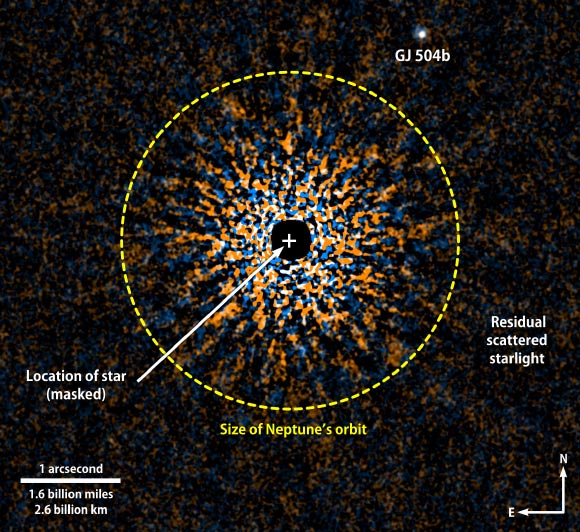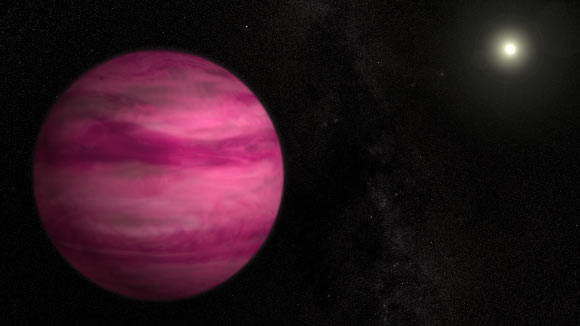Astronomers using the Subaru Telescope in Hawaii have captured a direct image of an exoplanet orbiting a Sun-like star.

This composite image shows the newly discovered exoplanet GJ 504b (NASA’s Goddard Space Flight Center / NOAJ)
The planet, labeled GJ 504b, is about four times the mass of Jupiter and similar in size. It orbits a G0-type star, GJ 504, located in the constellation Virgo about 57 light-years away.
The new world is the least massive planet ever imaged around a star like the Sun using direct imaging techniques.
“If we could travel to this giant planet, we would see a world still glowing from the heat of its formation with a color reminiscent of a dark cherry blossom, a dull magenta. Our near-infrared camera reveals that its color is much more blue than other imaged planets, which may indicate that its atmosphere has fewer clouds,” said Dr Michael McElwain of NASA’s Goddard Space Flight Center in Greenbelt, co-author of a paper accepted for publication in the Astrophysical Journal (preprint at arXiv.org).
GJ 504b orbits its parent star at 9 times the distance Jupiter orbits the Sun and has an effective temperature of about 237 degrees Celsius.
According to the core-accretion model, Jupiter-like planets get their start in the gas-rich debris disk that surrounds a young star. A core produced by collisions among asteroids and comets provides a seed, and when this core reaches sufficient mass, its gravitational pull rapidly attracts gas from the disk to form the planet.
While this model works fine for planets at distances less than 30 AUs, it’s more problematic for worlds located farther from their stars.
GJ 504b lies at a distance of about 43.5 AUs, according to the team. “The actual distance depends on how the system tips to our line of sight, which is not precisely known.”
Study co-author Dr Markus Janson of Princeton University said that GJ 504b is among the hardest planets to explain in a traditional planet-formation framework.
“Its discovery implies that we need to seriously consider alternative formation theories, or perhaps to reassess some of the basic assumptions in the core-accretion theory.”
______
Bibliographic information: Kuzuhara M et al. 2013. Direct Imaging of a Cold Jovian Exoplanet in Orbit around the Sun-like Star GJ 504. ApJ, accepted for publication; arXiv: 1307.2886








